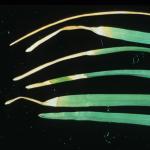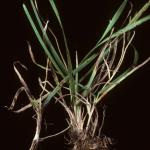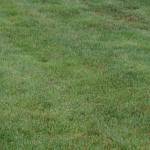Leaf Spot Diseases of Turf
The "leaf spot" diseases are widespread on cool and warm-season turfgrasses and are caused by many different genera of fungi. Many of these diseases are minor in impact while others are capable of causing major destruction; only the most important pathogens will be covered here.
Bipolaris sorokiniana affects all turfgrass species in the warm, wet summer months. Symptoms appear as small dark purple to black spots on leaf blades which enlarge with centers fading to tan, often with a yellow halo. The disease is confined to leaf blades in early stages, but sheaths, roots, and crowns can become infected during hot, humid weather. Leaf spots may coalesce causing large, necrotic areas and a general thinning of the turf. B. sorokiniana overwinters as dormant mycelium or conidia in infected plant tissues, thatch, and in plant debris. B. sorokiniana is favored by warm, wet weather and disease severity increases with rising temperatures. A period of drought stress followed by rewetting also encourages the pathogen. The life cycle and epidemiology of Bipolaris are similar to those of Drechslera poae.
Drechslera poae was once a very important disease of Kentucky bluegrass. It has become far less common in recent years due to the availability of resistant cultivars; however, it may still be seen on golf courses and lawns where older KBG cultivars persist. The disease occurs in the cool, moist weather of spring as black to purple spots on the leaf blade. Older leaves are more susceptible to infection and lesions can encircle the entire leaf blade causing girdling and the death of individual blades or tillers. Eventually, the fungus invades leaf sheaths, crowns, and roots causing the "melting-out" phase of the disease.The turf thins, turns yellow to blackish brown, and roots, rhizomes, and crowns exhibit a reddish brown, dry rot. When the weather turns warmer and drier, the surviving turf will begin to recover and fill in. D. poae survives unfavorable periods as dormant mycelium in infected leaf tissue, thatch, and plant debris. When environmental conditions are conducive, the fungus sporulates profusely and can be spread by wind, rain, irrigation water, equipment, and people. Conidia may be produced at a wide range of temperatures, but 58-64°F (14-18°C) is the optimum. The pathogen is favored by extended periods of leaf wetness, cool, overcast or foggy days, poor air circulation, low light intensity, high nitrogen levels, and excessive thatch and leaf clippings.
Red Leaf Spot caused by Drechslera erythrospila is a disease of bentgrasses. Symptoms are small reddish brown, oval lesions which coalese, resulting in an overall reddish cast to affected turf. The disease occurs in randomly distributed, irregularly shaped patches. Individual blades are often girdled and die giving the appearance of drought stress. The disease is favored by warm, wet weather and its epidemiology is similar to D. poae.
Gloeocercospora sorghii (copper spot, zonate leaf spot) occurs primarily on bentgrass golf greens. Copper spot occurs in warm, wet weather as scattered, circular patches 1-3 in. in diameter that are salmon to copper color. Individual blades exhibit small red to brown lesions which may coalesce to blight the entire leaf. Copper spot can cause severe thinning, but seldom kills the plants. Infected turf recovers slowly in cool, dry weather. G. sorghii produces fruiting bodies (sporodochia) containing a gelatinous matrix of salmon-colored spores under wet conditions and tiny, black, spherical sclerotia develop in dead leaf tissue. The pathogen overwinters as sclerotia and when conditions are conducive for infection, disease development occurs rapidly. This disease is favored by prolonged leaf wetness, plant exudates from recently moved turf, high nitrogen levels, and acidic soils.
Other minor leaf spots are caused by species of Ascochyta, Curvularia, and Leptosphaerulinia trifolii. These pathogens are weakly virulent and often invade weakened or senescing tissues or occur as components of a disease complex. Their presence is typically indicative of turf stress and improved cultural practices are frequently sufficient for treatment.
- Ascochyta leaf blight occurs throughout the year. Leaf lesions enlarge, girdle the leaf, and cause it to yellow and die. Fruiting bodies (pycnidia) form in the dead tissue and produce conidia which infect other blades, especially after mowing. The disease is favored by high atmospheric humidity, frequent irrigation, and frequent mowing. Mowing is an important factor in disease development as frequent mowing increases the number of infection sites and mowing when the foliage is wet can spread the pathogen.
- Curvularia species may be secondary invaders and not the primary cause of turf disease. Lesions of B. sorokiniana are invaded by Curvularia which is extremely aggressive at high temperatures. The occurrence of the two pathogens together causes greater disease than either can cause alone. Curvularia is considered to be a stress pathogen resulting from high temperatures or summer stress and may be secondary to other pathogens or poor cultural practices like low mowing.
- Leptosphaerulinia trifolii is a common soil inhabitant and unspecialized pathogen that attacks weakened or senescing tissues of many plants and is often found in association with other plant pathogens. Leptosphaerulinia Leaf Blight occurs on most turfgrasses particularly Agrostis, Festuca, Lolium, and Poa species. Large areas of turf may become blighted or symptoms may appear in small patches or spots. Individual leaves generally die from the tips down and may have yellow, brown, or reddish brown lesions. Entire leaves appear water-soaked and soon turn bleached white to tan. Leptosphaerulinia aggressively colonizes tissues stressed by other pathogens or environmental conditions and is favored by warm, humid weather, wet or compacted soil, drought stress, and low mowing heights.
Cultural Management
Follow accepted turfgrass management practices to prevent severe turfgrass stress. Improved cultural conditions and overseeding/renovation with resistant cultivars are often sufficient for disease mitigation.
- Raise mowing heights and reduce mowing frequency when conditions are conducive to disease development. Avoid mowing infested turf when it is wet.
- Water deeply and as infrequently as possible without causing moisture stress;avoid late afternoon or evening irrigation. Irrigate in the morning to reduce the duration of leaf wetness which favors disease spread.
- Avoid excessive levels of nitrogen, while maintaining adequate potassium and phosphorous fertility. Correct fertility is important to the turf's recovery and disease resistance.
- Aerate compacted soils. Soil compaction reduces water and nutrient infiltration and contributes to excess moisture in the plant canopy.
- Reduce thatch if it accumulates to more than 0.5 in. Pathogens survive in plant debris such as thatch therefore its reduction is a key component of cultural control.
- Selectively prune trees and shrubs to improve air circulation and light penetration.
- Reseed with improved cultivars with disease resistance or tolerance.
- Avoid applying herbicides or installing new sod during or just before an extended period of hot, humid weather.
Chemical Management
Leaf spot diseases may be favored by the overuse of certain systemic fungicides and herbicides. Avoid overuse of systemic fungicides such as DMIs as these chemicals can worsen disease damage through hormonal changes that reduce turf growth.



